Extreme And Interesting Weather On Other Planets In Our Solar System
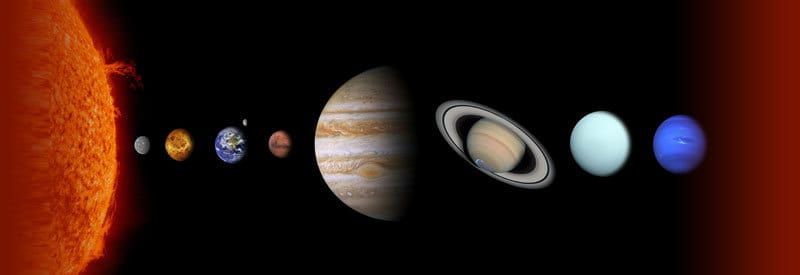
Earth experiences extreme and sometimes seemingly unexplainable weather events at times. But all these events pale in comparison to the extreme weather experienced on our neighboring planets.
With this in mind, it is just as well that we haven't advanced space travel to the point of being able to settle on any of our neighboring planets. Do you think the weather on our planet can get crazy and destructive? You might want to reconsider after reading this article.
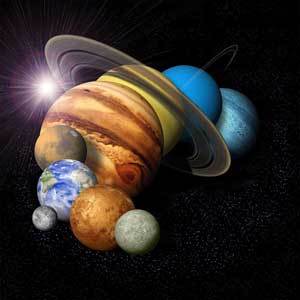
Since the latter stages of the Twentieth Century, we have been able to start exploring the planets in our solar system in much more detail. Hundreds of satellites and space probes have been launched and send on exploratory missions to our neighboring planets.
With these regular missions to explore the furthest reaches of our solar system, we are now able to get a much clearer picture of the weather on our neighbors.
Some of these findings are pretty scary and, at times, hard to believe. It sometimes paints a pretty horrific picture of extreme weather on a few of our neighboring planets.
Let's take a quick tour through all the planets, starting with the one closest to the sun and working our way outwards from there. We will focus on the standout features of the weather on each planet that makes it unique.
(I think we can give Earth a skip in this article. If you are interested, there are plenty of articles about all aspects of the weather on earth elsewhere on this website. If you feel like delving into Earth's weather, learn more about it, this is a good article to start with.)
The Weather On Mercury
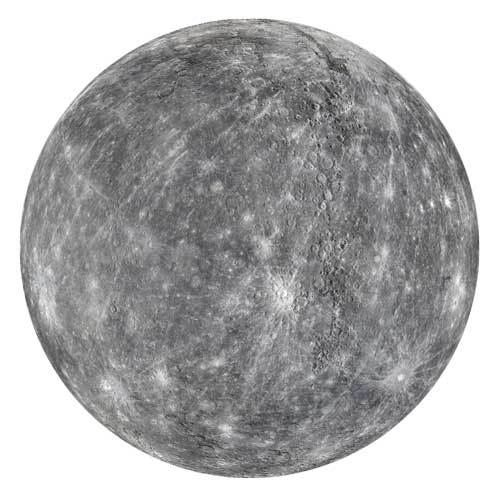
Mercury is the planet closest to the sun. Since it is nothing more than an empty rock, it has a dark gray color. Due to its small size and extreme temperatures, it has, for all intents and purposes, no atmosphere.
As a result, there is no weather activity on the planet. The little resemblance of an atmosphere there is consists of traces of oxygen, sodium, and hydrogen.
Its weak exosphere, however, contains a variety of gasses and elements. They include oxygen, calcium, hydrogen, calcium, helium, sodium, calcium, and some water vapor.
Temperatures On Mercury
When it comes to temperature, though, Mercury shows a lot more activity. Its lack of atmosphere makes it incapable of retaining any heat, which causes a deep contrast between day and night temperatures.
The side of the planet facing the sun reaches temperatures in excess of 427° Celsius (800° Fahrenheit), while the side in the shade of the sun drops to temperatures as low as -173° Celsius (-279° Fahrenheit).
It should be interesting to note, though, that Mercury is not the hottest planet in the solar system. Even though it's the closest planet to the sun, the lack of atmosphere prevents it from conducting and retaining any of this heat.
Storms On Mercury
As I already mentioned, Mercury has no weather. This means no storm activity.
Rainfall On Mercury
For the same reason, no rainfall occurs on Mercury.
Winds On Mercury
Again, the absence of an atmosphere also means no form of wind or any air movement is present on the planet.
(I know, pretty uneventful so far, but things are going to get a lot more interesting as we move on to the next planet.)
Mercury: Extreme Weather Summary
- Closest planet to the Sun
- Only planet without no active core
- Only planet with no atmosphere
The Weather On Venus
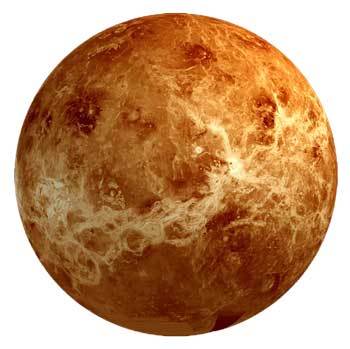
Venus is the second planet from the sun and Mercury's closest neighbor. Unlike Mercury, however, there is a lot more activity on this planet that makes it much more "interesting."
It has an atmosphere, which makes the presence of weather possible. Unfortunately, it is not the kind of weather you would enjoy. In fact, Venus is widely considered to be the planet with the most hostile environment in the entire Solar System.
The main reason for this diabolical environment is the extremely dense atmosphere on Venus. It is 90 times thicker than the Earth's atmosphere at sea level.
This means a diver on earth will need to reach a depth of 1000 meters (3280 feet) underwater to experience the same amount of pressure.
The atmosphere is also extremely toxic. With air containing carbon dioxide, nitrogen, and sulfur dioxide, life as we know it would just not be possible. And this is only the start...
Temperatures On Venus
Venus is the hottest planet in our solar system. This is thanks to a combination of the thick atmosphere and the carbon dioxide it consists of.
This combination allows for a significant amount of radiation from the sun to be trapped in the planet's atmosphere. This causes a rapid buildup and retention of very high temperatures in the atmosphere.
These temperatures build up to around 480° Celsius (900° Fahrenheit) and are consistently maintained all year long!
Storms On Venus
As you will soon discover, Venus is a pretty stormy planet. Quite a few flybys by space probes even detected lightning on the surface of the planet.
The rainfall (if you can call it that) is pretty extreme and, combined with fast wind speeds, complete the picture of a very stormy and unpleasant environment.
Rainfall On Venus
Venus does, in fact, experience rainfall. But when I talk about rainfall, I am not referring to rain in the form of water.
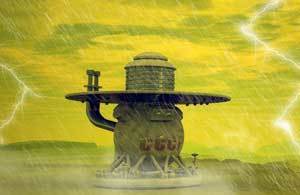
Depiction of sulfuric rain captured by Russia's Venera Space Probe
The rain that falls consists almost purely of sulfuric acid. (Yes, the kind that practically instantly dissolves clothing and eats through human flesh on contact.)
"Luckily," the surface is so hot that the sulfuric acid evaporates before reaching the ground. With surface temperatures hot enough to melt lead, this is hardly surprising.
Winds On Venus
Unfortunately, things do not get any better when it comes to wind. Winds reaching speeds in excess of 300 km//h (186 mph) can be found about 30 miles. This is stronger than the winds in our biggest hurricanes.
Fortunately, the wind dies down closer to the planet's surface due to the enormous pressure the atmosphere is exerting at this level. This means you only have to cope with the toxic air, crushing pressure, and temperatures that can melt metal.
Venus: Extreme Weather Summary
- Hottest planet in the solar system | 480° Celsius (900° Fahrenheit)
- Considered to be the planet with the most hostile atmosphere
- Closest planet to the Sun with an atmosphere
- Extremely dense atmosphere | 90 times thicker than Earth
- Rains sulfuric acid
The Weather On Mars
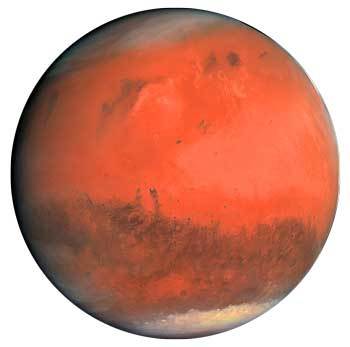
The Big Red Planet... Probably more fiction and non-fiction have been written, filmed, and discussed about Mars than all the other planets (and our moon) combined.
For some reason, we are fascinated by Mars and everything surrounding it. Maybe it has something to do with similarities between Earth and the Red Planet. This obviously brings us to the weather on Mars.
Mars is the fourth planet from the sun. (Earth is third, but remember we are skipping it for the purpose of this article.) Like its two closest neighbors, Mars has an atmosphere as well.
Its atmosphere is the direct opposite of the one you will find on Venus, however. Where the air on Venus is 90 times denser than on earth, Mars has an air pressure roughly 100 times thinner than that of Earth.
The atmosphere primarily consists of 95% carbon dioxide. Like Earth, Mars also has icecaps on its North and South Pole, consisting mainly of this carbon dioxide and water ice. This is similar to dry ice as we know it.
It makes conditions a lot more bearable but brings with it its unique challenges. The atmosphere is also still dense enough to support weather activity.
Temperatures On Mars
Due to its thin air and greater distance from the sun, the temperature on Mars is much lower than that on Earth. It is generally bitterly cold, with average temperatures in the region of -60° Celsius (-76° Fahrenheit).
However, it does get warmer and more bearable the closer you get to the equator. As Mars also experiences seasons, the summer temperatures are also not as cold as ones experienced during the wintertime.
Storms On Mars
When it comes to storms, Mars is not shy to show off some impressive and interesting unruly weather activity.
Huge Dust Storms (the largest in the solar system) can engulf the entire planet and last for months. Regional dust storms that occur every few weeks are more common but are still large in scale and can be very disruptive.
The approaching wall of red dust stretching for miles can be a very intimidating sight. (In case you were wondering why the surface of Mars is red, it is due to the large percentage of iron oxide present in the soil.)
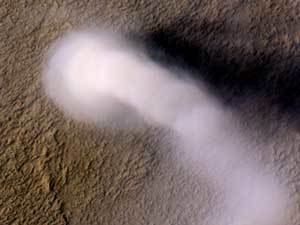
12 Mile High Dust Devil On Mars
Dust Devils are also another uniquely Martian phenomenon. They closely resemble the tornadoes we experience on Earth visually, but very little is actually known about how they are formed.
These harmless whirlwinds appear frequently and in large numbers across the planet. At any given time, there are literally millions of dust devils present on the surface of Mars.
They are only about 13 meters (42 feet) in diameter but can easily reach up to 1000 meters (3280 feet) in height. You can imagine the sight of observing a dozen of these dust devils racing across the red surface of the planet.
Rainfall On Mars
Although exploration by multiple satellites and surface probes revealed the possibility of surface waters long ago, the atmosphere of Mars is very dry.
As a result, no current rainfall or traces of it in the past has ever been detected.
Winds On Mars
Winds are present on Mars in many different forms. We have already seen its activity in the dust storms and dust devils we discussed in the previous section.
Although the winds can get pretty strong, they are not nearly as strong or destructive as the ones found in some hurricanes on earth and the heavy winds found on other planets.
Mars: Extreme Weather Summary
- Planet most likely to support life (apart from Earth)
- Huge dust storms covering entire planet
- Polar ice caps on North & South Pole
- Millions of dust devils (small tornadoes) across planet
The Weather On Jupiter
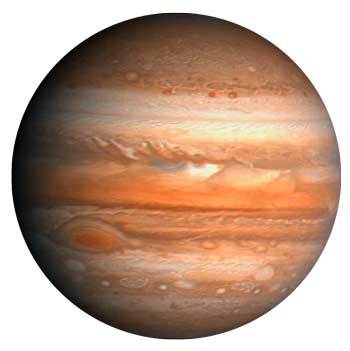
This brings us to Jupiter, the fifth and largest planet in our solar system. It has three hundred times the mass of Earth and two-and-a-half times the mass of all the planets in the solar system combined.
Jupiter is also considered to be one of the gas giants. This is because the planet has no solid surface and consists of 90 percent hydrogen. The remaining 10 percent consists mainly of helium.
These denser gasses are heaped on top of each other to form the "body" of the planet. Since Jupiter has no solid surface, its surface is determined at the point where the atmospheric pressure is the same as that on Earth.
Jupiter has a very dense and dry atmosphere. It consists mainly of hydrogen and helium, with smaller amounts of ammonia, water vapor, methane, and silicon-based elements.
As you will soon discover, Jupiter's weather is very active and violent. Some of the weather events are so extreme, they are visible from both Space and Earth.
Temperatures On Jupiter
The average temperature on Jupiter is about -145° Celsius (-234° Fahrenheit). This is the atmospheric temperature of the planet.
As there is no clear distinction between the surface and the atmosphere, the temperature keeps rising as you move closer to the center of the planet. The rocky core of Jupiter, sitting far below the surface, is a blistering hot 20 000° Celsius (36 000° Fahrenheit).
Storms On Jupiter
To say that Jupiter is characterized by some of the most violent and extreme storms in the solar system is not an understatement.
As already, some of these storms are so big, it can be observed from space. Many of you will be familiar with the famous Great Red Spot on Jupiter.
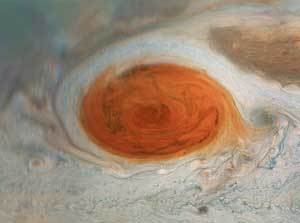
Jupiter's Great Red Spot
The Great Red Spot is nothing more than an enormous cyclonic storm on the surface of the planet. It is roughly 40 000 km (24 900 miles) in diameter and dates back as far as 1665 when astronomer Giovanni Cassini discovered it.
This storm is not the only one of its kind occurring on Jupiter, however.
Winds drive multiple large storms called wind storms with speeds reaching 620 km/h (385 mph). These storms take shape very rapidly. They start to form within hours and grow to thousands of kilometers in width in less than a day.
Clouds are formed at different latitudes in areas called the "tropical regions." It is this layered cloud system that gives Jupiter its distinct banded appearance. They are created and driven by jet streams at speeds of 482 km/h (300 mph).
The gigantic storms that are so commonly found in the atmosphere are formed within these clouds.
Storms very similar to those occurring on Earth can also be found on Jupiter. Lightning storms are common, and large cyclones can be found in the polar regions. I already mentioned the wind storms that are raging across the surface of the planet.
The big difference between the storms on Earth and Jupiter is the sheer size strength. The storms on Jupiter completely eclipse those on our planet. Some of these storms are actually the size or larger than Earth itself!
Rainfall On Jupiter
Rainfall does occur on Jupiter, just not the type you would expect.
If you choose to believe some publications from media outlets, it actually rains diamonds on Earth. Obviously, it is a theory that has been taken entirely out of context.
It can be true, however. The working theory among scientists is that carbon (in the form of soot) is formed in the upper atmosphere as a result of lightning strikes.
As the soot falls through the atmosphere, the immense air pressure hardens and turns it into graphite. In turn, as the graphite continues to fall to the surface, the pressure gets so high that it is compressed into diamonds.
Needless to say, this theory has not been proven yet, and it will be hard to do so in the near future. The conditions are just too hostile for any probe to survive the extreme conditions.
There is a general consensus among scientists, however, that there is a strong possibility that this theory is indeed correct. I'll leave this one for you to make up your own minds.
Another form of precipitation on Jupiter is helium rain. Helium starts as a mist in the upper layer of the atmosphere. At this height, the temperature is around 5000° Celsius (9000° Fahrenheit), which allows hydrogen to turn into metal, but not helium yet.
This means the hydrogen and helium do not mix. As the droplets of helium grow bigger, they combine with neon and start falling towards the surface of the planet.
Winds On Jupiter
Jupiter experience some of the strongest winds of any planet in our solar system. I already mentioned the Great Red Spot, where wind speeds reach 620 km/h (385 mph). This is almost twice the maximum wind speeds measured within major hurricanes on Earth.
A smaller storm named the Little Red Spot by scientists contains some of the strongest winds ever detected on a planet. The winds in this storm are considered to be at least as strong as the winds observed in the Great Red Spot. And it is still growing...
At North and South Poles, the cyclones rotating each pole's central storm contain very violent winds with speeds of up to 350 km/h (220 mph).
These are just a few standout examples of the extreme and violent winds present in storm systems and jets streams across Jupiter's surface.
Jupiter: Extreme Weather Summary
- The largest planet in the solar system (300 times the mass of Earth)
- Great Red Spot the largest and oldest storm at 40 000 km (24 900 miles) in diameter
- Rains diamonds and helium
The Weather On Saturn
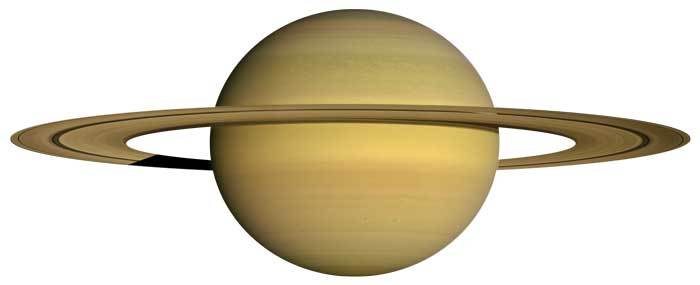
Jupiter's next-door neighbor is another gas giant. Saturn is the sixth planet from the sun and also the second biggest planet in size and mass.
Saturn is probably the most well-known planet (except perhaps Mars) in our solar system as a result of its unique features. Its rings make it instantly recognizable. It is also one of the very few planets that are visible to the naked eye.
Unfortunately, size and looks will only get you so far. Upon closer inspection, it turns out Saturn has a lot in common with Jupiter when it comes to its weather. And not in a good way.
It has 95 times the mass of Earth and is so big that it can hold 760 Earth-sized planets. However, it is the least dense of all the planets. It's the only planet that has a density less than that of water.
Like Jupiter, Saturn's atmosphere consists mainly of 96% hydrogen and 3% helium. (There are trace elements of other gasses and heavier elements, but their small volume makes it insignificant.)
The atmosphere also shares Jupiter's volatile and extreme weather. We will break down the different weather elements in the following sections.
In general, though, the weather on Saturn is characterized by violent storms, high-speed winds, and freezing temperatures.
Temperatures On Saturn
Saturn is freezing cold with an average temperature of -178° Celsius (-288° Fahrenheit). This is mainly due to the planet's vast distance from the sun.
It also does not have a solid surface, which means the little heat from the sun can not be absorbed and retained.
There is no significant temperature difference between the equator and the poles, as the heat that is generated, comes from the planet's core. This means the majority of the heat is generated in Saturn's interior.
There is a variation in temperature, and this variation is directly tied to the three layers of clouds covering the surface.
The upper layer, containing ammonia ice, is the coldest, with average temperatures of -173° Celsius (-280° Fahrenheit).
The middle layer sees a rise in temperature. The air is still cold when judged according to human standards, with average temperatures around -88° Celsius (-128° Fahrenheit).
The third and lowest layer shows a significant increase in temperature due to its relative proximity to the planet's core. The average temperature in this layer is a "blistering hot" 57° Celsius (134° Fahrenheit).
Storms On Saturn
As already mentioned, the weather on Saturn is very much like that which you will find on Jupiter. This includes its stormy nature. An abundance of massive and violent storms are regularly occurring across the planet.
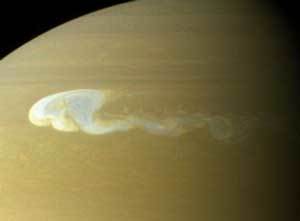
Saturn's Great White Spot
An extraordinary phenomenon that occurs approximately every 30 years is called the Great White Spot (aka The Great White Oval). This oval-shaped storm system is so big it can be seen from Earth. The clouds which give it its white appearance can grow from several thousand miles in diameter to encircling the entire planet.
These global thunderstorms produce severe lightning and large cloud disturbances. Apart from the oval-shaped head, the storm is also characterized by a tail that keeps growing and eventually spirals the entire planet.
Another prominent storm feature of Saturn is the six-sided storm (Saturn's Hexagon) that has been raging over the northern pole of the planet for decades already.
The six-sided storm is approximately 29 000 kilometers (18 000 miles) in diameter. It also has an unusually big vertical buildup, starting far down in the lower atmosphere and topping out at a height of around 300 kilometers (190 miles).
There is much speculation about how exactly this hexagonal storm is formed. One popular theory is that it is the result of a jet stream (containing atmospheric gasses) rotating in the atmosphere around the polar region.
The cloud bands that normally surrounds storm systems on Saturn is what gives the planet its uniquely streaky look. (As is the case with Jupiter).
Rainfall On Saturn
Even the rainfall on Saturn closely resembles that of Jupiter.
It also "rains diamonds" on Saturn, and the same theory that is applicable for diamond formation on Jupiter applies here. There is one possible point of confusion that we need to be cleared up, though.
It is the immense pressure in Jupiter's atmosphere that plays a key role in the formation of diamonds. Yet, as you've learned earlier in this section, Saturn has an extremely low density. Then why would diamonds still be able to form under these conditions?
It is very straightforward, really. It is the density of the planet itself that is so low, not its atmosphere. The atmosphere is almost identical to that of Jupiter in many ways which makes it just as ideal for diamond formation.
Saturn also experiences what is called "Ring Rain." It is the different particles and elements that fall from Saturn's rings to the surface of the planet.
It has recently been discovered that this rain doesn't just consist of a variety of different elements, it is also a more persistent downpour than just a drizzle.
The rain consists of hydrogen, water, butane, and propane. Some of these are considered to be "complex organics." Much of this data was captured by NASA's Cassini spacecraft as it made its final descent before crashing into the planet.
Winds On Saturn
The winds on Saturn are some of the fastest in the solar system, only beaten by Neptune when it comes to maximum speeds. Near the equator, the winds in the upper atmosphere reach speeds of up to 1 800 km/h (1 118 mph).
Although violent and fast-moving winds occur (and form and define the majority of storms) all across the planet throughout the year, there is more weather event which contains some severe winds.
Saturn's Hexagon, the massive six-sided storm raging at Saturn's northern pole, is surrounded by winds with speeds reaching 530 km/h (330 mph). That is almost double the maximum wind speeds attained in Earth's most powerful hurricanes.
Saturn: Extreme Weather Summary
- The planet characterized by its well-known rings
- The second-largest planet in the solar system
- Very strong wind speeds at 1 800 km/h (1 118 mph).
- Jupiter also experience Rain Ring (Particles falling from its rings)
- Rains diamonds
The Weather On Uranus

We are now starting to wander very far away from the center and heat source of our solar system, the Sun. Uranus, the seventh planet from the sun, is one planet that is showing some clear evidence of this fact.
Uranus is officially the coldest planet in the solar system, with the temperatures in the atmosphere dropping as low as -218° Celsius (-370° Fahrenheit).
Like Jupiter and Saturn, it is also one of the four gas giants. It differs from them in some significant ways, though.
It is also unique compared to other planets, as this planet is entirely turned on its side and spinning at 90 degrees as a result. This means the little heat from the sun warms the poles, not the equator, as is the case with the other planets.
Initially considered to be a rather dull and uneventful planet, recent discoveries by the Hubble Space Telescope shows Uranus to be more active with some storm systems, bands of clouds, and winds occurring across the globe.
Temperatures On Uranus
As I already mentioned, Uranus is the coldest of all the planet with an average temperature of -218° Celsius (-370° Fahrenheit). It is no surprise that it is referred to as one of the two ice giants, next to Neptune.
The interior temperature of the planet is far cooler than that of other planets, which means less heat is radiated from the planet itself. (Due to its much lower temperature, there is a lot more certainty among scientists that it contains a solid rocky core.)
As a result of the planet's low temperature, its coldest at the surface and warms as altitude increases above the planet's surface.
The troposphere closest to the surface, which contains some elements of weather, is a freezing -218° Celsius (-370° Fahrenheit).
Higher up in the troposphere, the sun's radiation starts to have some effect, and temperatures rise slightly to a more bearable -153° Celsius (-243° Fahrenheit).
The outer layer of the atmosphere contains the highest temperatures found on the planet, which is directly exposed to the sun's radiation. Temperatures can reach up to 577° Celsius (1 070° Fahrenheit).
Storms On Uranus
Even though the planet's core temperature is much colder than that of other planets, it still seems to be the main driving force of all weather activity in the atmosphere.
Although not nearly on the scale of Jupiter and Saturn, there is some storm activity on Uranus. The type of storm activity in the atmosphere is also very similar to that of the two larger planets, just on a much smaller scale.
It has bands of storms that orbits the planet. (These bands are mostly obscured by the amounts of methane in the upper atmosphere, giving the planet its blue tint.) The weather systems on Uranus are much smaller than on other planets, but things can still get pretty stormy.
The clouds in the storm systems mainly consist of methane ice crystals. Some of these storms can still reach some respectable sizes. (In 2006, the Hubble Space Telescope identified a dark cloud on Uranus' surface, which turned out to be storm two thirds the size of the United States.)
Rainfall On Uranus
As the weather resembles that of Jupiter and Saturn so closely, it should come as no surprise that rainfalls consisting of diamonds are also believed to occur on Uranus.
There does not seem to be any other form of rainfall present on the planet. Nothing significant has been discovered or identified yet anyway.
Winds On Uranus
The winds are not as strong as its two bigger neighbors but can still reach speeds of up to 900 km/h (560 mph.)
At the equator, the winds blow in the opposite direction as the rotation. Closer to the poles, however, the wind direction changes and the winds start blowing in the direction of the planet's rotation.
Uranus: Extreme Weather Summary
- The coldest planet in the solar system | as low as -218° Celsius (-370° Fahrenheit) at the planet's surface
- Methane layer in upper atmosphere gives the planet is blue tint
- Rains diamonds
The Weather On Neptune
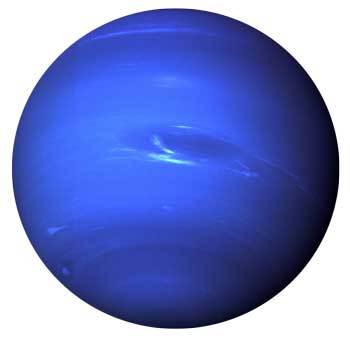
This brings us the eighth and last planet. At 4.5 billion kilometers (2.8 billion miles), Neptune is also the furthest planet from the sun.
It is the last of the four gas giants. Like most of the other gas giants, Neptune has a very active weather system.
The weather is characterized by huge & violent storms, high wind speeds, extreme temperatures, and some "interesting" rainfall. You should start to notice a familiar pattern emerging when it comes to describing weather on any of these gas giants.
Temperatures On Neptune
Due to its distance from the sun, Neptune receives very little solar radiation or heat. As a result, it is one of the coldest planets in the solar system, with temperatures as low as -218° Celsius (-360° Fahrenheit).
As I previously mentioned, it is because of its icy atmosphere that Neptune is referred to as an ice giant (alongside Uranus).
Because the planet has no solid atmosphere being a gas giant, the surface is calculated at the point where the air pressure is the same as on earth. At the "surface," the air temperature is in the region of -210° Celsius (-346° Fahrenheit).
Temperatures also react differently in the planet's two atmospheric layers, the troposphere and stratosphere. In the troposphere (the lower layer starting at the planet's surface), the temperature decreases as the altitude increases.
The stratosphere (starting above the troposphere) reverses this trend and shows a constant increase in temperature as altitude increases.
We normally associate the north and south poles with the coldest temperatures on the planet. This not the case with Neptune, however. It is tilted at just a little more than 28 degrees on its axes, with the South Pole facing the sun during the summer months.
This means for the entire summer on Neptune (which lasts 40 Earth years), the South Pole is hotter than the rest of the planet by about 10° Celsius (18° Fahrenheit).
Storms On Neptune
As a gas giant, combined with the fact that it contains a much warmer core than Uranus, it makes Neptune one very stormy planet.
The majority of storms are in the shape of bands (like Jupiter and Saturn) circling the planet and driven by high winds.
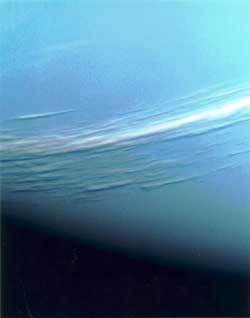
Neptune's Fast Cirrus Clouds
A unique and interesting feature is Cirrus clouds circling the planet at high altitudes. They travel extremely fast and make a full rotation of the planet every 16 hours! They also consist mainly of methane ice crystals.
The most fascinating and mysterious phenomenon that the Voyager II spacecraft found in its 1989 flyby is the "Great Dark Spot," the name given to it by scientists. The consensus was that this spot was a huge cyclonic storm, very much like Jupiter's Great Red Spot.
When the Hubble Space Telescope tried to locate it years later, it disappeared, but a new dark spot was discovered further north. Astronomers argued that these appearing and disappearing dark spots could be holes created in the methane clouds.
No conclusion has yet been reached as to what exactly these mysterious dark spots are. However, whether gigantic cyclones or holes in clouds, they do point to a very active and stormy weather system.
Rainfall On Neptune
It may come as no surprise at this stage, but yes, as is the case with other gas giants, diamond rainfall is believed to occur on Neptune. (For the same reason as on other gas giants.)
The gaseous and warm core makes any other form of rainfall unlikely. Even if it occurs, it will probably evaporate long before reaching any type of solid ground. (With no solid surface, in theory, it will just continue to fall towards the core of the planet.)
Winds On Neptune
It has already been determined that Neptune is a very windy planet, with many of them encircling the banded storm systems across the planet.
Neptune has the honor of being the planet with the fastest wind speeds in our solar system. Winds can reach speeds of up to 2 100 km/h (1 305 mph). That is almost twice the speed of sound on Earth!
Scientists are not sure why the winds reach such high speeds, but scientists theorize that the extremely cold weather reduces friction, which allows for higher speeds.
Neptune: Extreme Weather Summary
- The planet with the fastest wind speeds in the solar system | in excess of 2 100 km/h (1 305 mph)
- The second coldest planet in the solar system
- The furthest planet from the Sun
- Rains diamonds
Conclusion
So, after reading through this article, do you still think the weather on Earth can get pretty extreme, violent, and downright destructive?
If you do, you will not be wrong. And with Climate Change playing its part, it's bound to get worse over the coming years.
Looking at the weather on other planets, you have to admit though, that our most extreme weather systems pale in comparison to "normal" weather on our neighboring planets.
The goal was not to draw comparisons, but just to give you a small peek into what weather is like on the other seven planets in our solar system.
And also how small our planet and its weather systems are in comparison to our neighbors. And our solar system is only our little corner of space. We have no idea what exactly is happening on planetary systems elsewhere in our own galaxy, and at the scale, it is happening.
I hope you found this quick tour through our solar system fascinating and helped you to get some perspective as to how much our little planet, with its human-friendly atmosphere and weather systems, support and protect us.
We better take care of it and not screw it up. As you have seen, there is no real alternative or Plan B out there...
Never miss out again when another interesting and helpful article is released and stay updated, while also receiving helpful tips & information by simply following this link .
Until next time, keep your eye on the weather!

